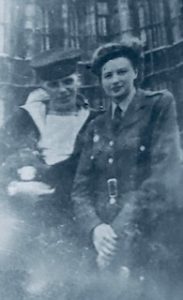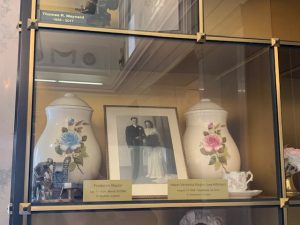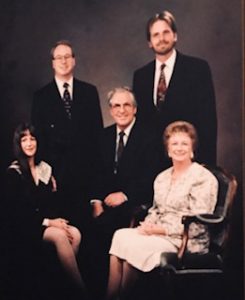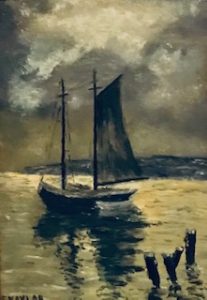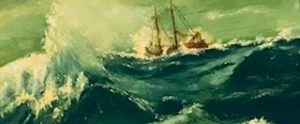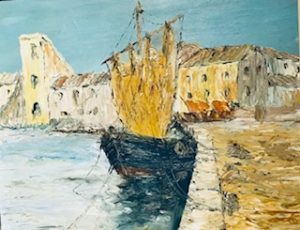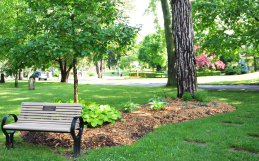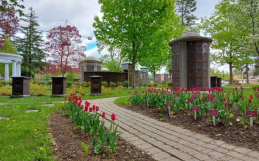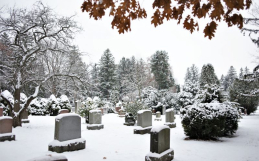2019 Remembrance Day Legacy Story – Frederick Naylor
By Susan Farrelly
It was an honour to write about Navy veteran Frederick Naylor for this Remembrance Day Service. Information about Fred’s life has been obtained from Fred’s son Ken Naylor, Fred’s own voice in an audio interview conducted by his grand-daughter Julie from 1990, as well as autobiography notes written by Fred himself.
Frederick Naylor was born on July 17, 1924 at Heeley Place in Sheffield, Yorkshire, England. His Father Frank Naylor and mother Florence Barker had another son named Edward shortly afterwards. During Fred’s early years, the family moved a couple of times and Fred attended school at St. Silas, a church school starting in 1929 and Heeley Bank Council School starting in 1932.
Fred had various jobs during his teenage years showing his strong work ethic. Fred’s first job was in 1937 at 13 years of age delivering papers in the morning and evening six days per week including on Sundays, for a payment of only sixpence per week. At the age of 14, Fred started working full-time in a cutlery factory. Fred worked 48 hours per week at this job and after breaking a finger and sustaining an eye injury, he quit after six months.
Fred then worked for an electrical contractor and then at a co-op as a van boy delivering groceries and bakery products until the age of 15. At age 16, he started working at Firth-Brown Steelware and was employed in the machine shop and later transferred to the melting department where he worked various jobs including as a crane operator and electric furnace worker.
During this time, the Second World War had begun and Fred joined the Civil Defence force as a messenger boy. It was December 12, 1940, when Fred was working the evening shift and the bombing started. This became known as the Sheffield Blitz and it was a concentrated attack on Sheffield by the Germans that lasted three days. Sheffield was targeted due to being a hub of steel manufacturing that was aiding the war effort. On this evening when Frederick was at work, the bombs were dropping on the other side of the City and those working on Fred’s shift did not know how bad it was. Fred felt it was his duty to be at his home district, so he quickly left and walked home.
The City Centre was burning but Fred was able to skirt around the fires to make his way home. After he reached home he heard bombs falling and ducked under a wall. He saw houses burning and tried to help by using a small water hose to put out the fires; however, the water ran out so his efforts were in vain. His lasting impression was the constant noise of aircraft and the fires in the City Centre, which could be seen from his district and the brilliant flares that were dropped by the bombers. In the end, it was a scene of devastation and Sheffield was never the same city again.
Fred’s bravery was noticed and afterwards he received a personal letter from the Civil Defence Office of the Regional Commissioner that said,
“Dear Mr. Naylor – Your work during the heavy air raid on Sheffield in December 1940 has been brought to my notice, and as Regional Commissioner I should like to express to you my high appreciation of your courage in fighting a fire single-handed, although the bombing was at its height. I congratulate you on your good work, and send you my best wishes.”
This letter of thanks certainly meant a lot to Fred, as he kept it in safekeeping throughout his entire life.
After the Sheffield Blitz, Fred worked long hours making steel for the war effort. By the time that Fred was 18, all of his friends had joined the armed forces. In his own words, Fred wrote, “I had enough of long work hours and wanted to get in to the war before it ended. How naïve I was in those days.” When Fred was 18, he volunteered for service in the British Navy. He started to serve in August 1942.
While in the Navy, Fred served aboard minesweepers, which were naval vessels used to clear sea lanes of mines. The Axis and Allied nations laid a total of more than 550,000 submarine mines in World War II and the presence of these mines in the sea continued to be a danger even after the war ended. During World War II, Great Britain and their allies lost approximately 1,100 vessels to mines.
The minesweeper that Fred served on was a relatively small, 50 meters long vessel, and it was equipped with destroying all types of mines. Fred’s duties included operating and maintaining the engines as well as being on look-out and part of the firing party when shooting at the mines with rifles and machine guns. Fred shared during his interview, “By far the biggest enemy was the weather, and as we were such small ships, about the size of a fishing trawler, we were thrown all over the ocean during a storm, and were often soaked to the skin which made us cold and miserable.” Most of the operations Fred took place in were around Britain in the English Channel.
In 1944 after DDay, Fred took part in one of the largest minesweeping operations of the war with over 100 sweepers used, as the river was full of mines as the Germans wanted the Allies to stop using the port of Antwerp which had been taken by Canadians and the British. As Fred’s minesweeper approached, the Germans were firing at some of the sweepers, gunfire was seen on both sides of the river, and they passed several sunken landing craft. They went by an enemy fortress and fortunately, for Fred’s crew, the Germans standing on the fortress were holding a white flag as they were watching Fred’s minesweeper go by. They found out later that they had surrendered as they had run out of ammunition. The minesweeping operation went on for six weeks and some minesweepers were lost or heavily damaged. When they finally arrived in Antwerp, they were under heavy attack. When they were arriving at the port, they witnessed an explosion of a V2 rocket, which was the world’s first long-range guided ballistic missile. They stayed in Antwerp for a few days, and they found it far more dangerous due to the V1 and V2 rocket attacks than sweeping mines, so Fred remarked that they were glad to get away from there.
There is a particularly bittersweet memory that Fred shared during his interview. Fred remarked, “During our stay in Holland, we often visited the town of Terneuzen and the people were grateful for being liberated. Terneuzen is at the mouth of the river shelf, and after we had cleared the mines in that area, we went ashore for the first time. We were shocked to see the food stores empty, and gave food to the people and candy to the kids who didn’t know what it was at first and then ran off to show their mothers what they’ve got. After that, all the kids came to the dockside dressed in their best clothes and we threw candy to them from the deck of the ship. I guess we just about cleared all of our stock of candy out. One thing I regret is that I refused the offer of a little boy to go to visit his home. The reason I refused was because I didn’t want to go and eat their food as I knew they would insist on giving it to me, and they had so very little. But looking back, I wished I had gone with him. It’s funny but it’s little things like that, that stick in your mind, not the big events.”
Overall, Fred shared that he liked the travel that was involved in the Navy, travelling from port to port, and seeing different people and places. He especially enjoyed the companionship amongst all the crew, referring to them as his ‘buddies.’ Fred served the Navy for four years, and his service on various vessels took him to Spain, Malta, North Africa, Egypt, Southern India and Ceylon (which is now Sri Lanka). In the interview with his granddaughter, he shared many memories, including seeing baboons hanging from bridges in North Africa and coming across an elephant on the street in Ceylon. Fred was saddened to see the poverty in the Far East. He recalled how people would paddle out to sea in canoes to catch the garbage that the crew threw overboard after their meals, diving down to eat it. He was also struck by the amount of poverty in Southern India especially, with people of all ages begging and sleeping on the sidewalks.
During this time the Atomic bombs had been dropped on Japan and the war was finished. After leaving Ceylon and spending a few months in Singapore, he boarded a Cruiser (HMS London) and returned to England. Fred shared, “The nicest sight that I ever saw were the green fields of England when we got back again. I sure was glad to get back there.”
During the early days of Fred’s service while at a dance, he met a beautiful woman named Hazel who served in the Women’s Army Auxiliary. Fred and Hazel corresponded by letter from the time he left England until his return, and they married in 1946 when Fred was 22 years old. Fred returned to his old job at Steelware, but found it very hard to settle and Hazel was finding it hard to adjust to life in Sheffield. In 1947, they went to live at her home in Purbrook where they had their first son, Ken, in October. In the meantime, Fred was training for work as a Blacksmith and in 1948, they returned to Sheffield as there was no work available around Portsmouth.
Shortly after the birth of Marlene, their daughter, Fred and Hazel decided they wanted a better life for their family and had their sights set on Canada. In 1956, Fred and his friend came to Kitchener and got an apartment as Fred worked as a welder in a fabricating plant. The following year, Fred sent for Hazel and the kids to join him in Canada. Ken remarked, “Mom came over to Canada with Joe’s wife on a boat with a young child and a toddler. Mom was very courageous.” They had a third child, Phillip. Shortly afterwards, Fred and Hazel settled in Guelph to raise their family.
The Naylors and their children, pictured above.
Fred worked various jobs to provide for his family, including working at the University of Guelph as a Blacksmith. Fred was also a Farrier on the side, and one of Ken’s most precious memories was when he was 15 years old; he went with his dad to help him shoe some Clydesdales. Fred would get the horseshoe in form, and forge it to fit the horse while Ken tried his best to hold the horse still.
Over the years living in Guelph, Fred found much joy out of his life. His hobbies included spending time with his family and grandchildren, going to thrift stores to get the best deals that he could find, doing some ornamental blacksmithing, and oil painting. His paintings focused mainly on beautiful scenes involving boats on the water, likely a result of the life-long impact and memories that service on the sea provided him.
A collection of Fred’s oil paintings above.
After a short illness, Fred passed away on March 26, 2002 at the age of 77. He was cremated and his ashes were laid to rest in the Mausoleum at Woodlawn Memorial. Hazel passed away 10 years later and her ashes are with his, as they are memorialized with a photo from their wedding in the niche where they are interred.
Fred’s memory lives on in his precious family members – many of whom are here today – and we thank Fred for his bravery, service and sacrifice. Thank you to the Naylor family for preserving Fred’s memories and his voice, so they can be he heard and shared today at this service.
Sources:

